ATKINSON FACULTY OF LIBERAL AND PROFESSIONAL STUDIES
SCHOOL OF ANALYTIC STUDIES & INFORMATION TECHNOLOGY
S C I E N C E A N D T E C H N O L O G Y S T U D I E S
STS 3700B 6.0 HISTORY OF COMPUTING AND INFORMATION TECHNOLOGY
Lecture 6: Ancient Hardware
| Prev | Next | Search | Syllabus | Selected References | Home |
| 0 | 1 | 2 | 3 | 4 | 5 | 6 | 7 | 8 | 9 | 10 | 11 | 12 | 13 | 14 | 15 | 16 | 17 | 18 | 19 | 20 | 21 | 22 |
Topics
-
So far we have focused on what, using conteporary terms, we could call ancient software. It is therefore time that we survey,
equally briefly, ancient hardware, that is the most important computing artifacts actually constructed in antiquity.
A system that was used by almost all cultures, well into the nineteenth century, is that of knotted cords or notches cut into tally sticks. Numerous examples are mentioned in the Bible and can be found in the religious paraphernalia of many religions.
"Even as late as the third century A.D. the tax gatherers in Roman Palestine were using knotted strings both for their own records and for receipts. Even when this mechanism was replaced by writing, the receipts were still referred to as publican's knots.
In Germany, up to the end of the nineteenth century, millers would use knots to record the amount and kind of flour they delivered to the bakers. The strings used to close the flour sacks would be knotted in specific ways to record the sack's contents.
The practice of using knotted records was also common among various groups of American Indians from the interior of British Columbia to the middle of South America. The Incas, from the northwest coast of South America, were the only one to really develop the system beyond the simple recording of elementary items such as the number of days that had elepsed from a given event
[…] Their use of knotted strings reached its highest development in the fifteenth and sixteenth-century Inca empire device known as a quipu [or khipu] (quipu was the Inca word for knot). The quipu had two basic functions: it would record purely numerical information, and it also would act as an aide-memoire for the record keepers in recalling historical traditions, poems, lists of kings, and so on. " [ M R Williams, History of Computing Technology (IEEE Computer Society Press 1997) ] -
One of the earliest examples of tally sticks is the Lebombo Bone,
"a small piece of the fibula of a baboon […] dated approximately 35,000 BC," which exhibits "29 clearly defined notches,
[and] resembles the calendar sticks still in use by Bushmen clans in Nimibia."
An even more famous artifact is the so-called Ishango Bone,
which was found on the shore of Lake Edward, on the borders of Uganda and Zaire. It dates from somewhere between 9000 and 6000 BC.
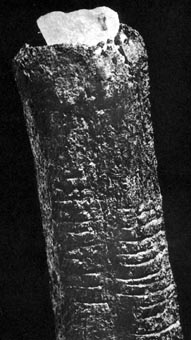
The Ishango Bone
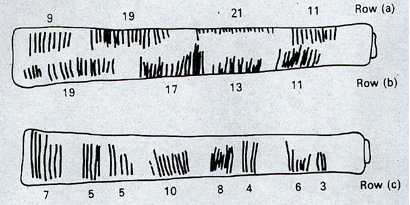
The Notches on the Ishango Bone
"It was first thought these notches were some kind of tally marks as found to record counts all over the world. However, the Ishango bone appears to be much more than a simple tally. The markings on rows (a) and (b) each add to 60. Row (b) contains the prime numbers between 10 and 20. Row (a) is quite consistent with a numeration system based on 10, since the notches are grouped as 20 + 1, 20 - 1, 10 + 1, and 10 - 1. Finally, row (c) seems to illustrate for the method of duplication (multiplication by 2) used more recently in Egyptian multiplication. Recent studies with microscopes illustrate more markings and it is now understood the bone is also a lunar phase counter. Who but a woman keeping track of her cycles would need a lunar calendar? Were women our first mathematicians?"
-
A very important and versatile computing device, with a very long history, is the ubiquitous
 abacus. One of the earliest surviving example of abacus is the marble one illustrated
below. It was found on the island of Salamis, Greece, but it originates from about 3000 BC in Babylonia. Of great interest is the fact that it includes
three x-marks, presumably intended to be replaced by actual values.
abacus. One of the earliest surviving example of abacus is the marble one illustrated
below. It was found on the island of Salamis, Greece, but it originates from about 3000 BC in Babylonia. Of great interest is the fact that it includes
three x-marks, presumably intended to be replaced by actual values.
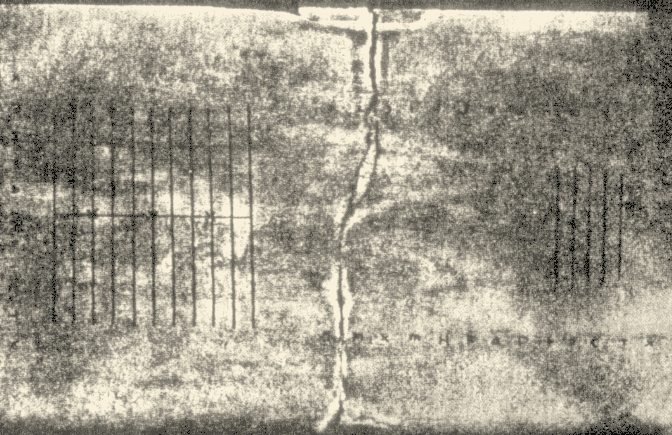
The Babyonian Salamis Tablet (ca 3000 BC)
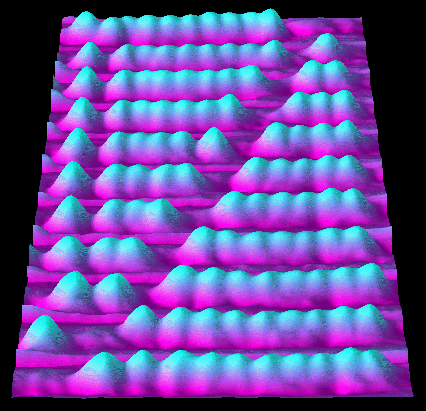
IBM's Smallest Abacus (ca 1996 AD)
The picture above represents the 'modern end' of the abacus' history. It is a scanning tunneling microscope image of the world's smallest abacus, which scientists at the Zurich Laboratory of the IBM Research Division built "with individual molecules as beads with a diameter of less than one nanometer, one millionth of a millimeter." -
It is interesting to trace the origins of the word abacus. The common etymology is that it derives directly from Latin (abacus) and
Greek (abax), and meant slab, board, and thus counting board. According to some linguists, abacus may be related
to the Hebrew abaq or avaq, that is dust. Others point to the Phoenician abak, or sand. If such
more ancient origins can be confirmed, they would suggest that the earliest calculations were performed by writing in the sand, perhaps a thin layer
deposited on a flat surface, a slab—a rather precarious arrangement. Later abaci were carved in stone, with grooves along which small pebbles
(notice that the Latin word for pebble is calculus) could be easily positioned and moved.
"For more than 15 centuries the Greek and Romans and then Europeans in the Middle Ages and early Renaissance calculated on devices with authentic place-value system in which zero was represented by an empty line, wire or groove. Yet the written notations did not have a symbol for zero until it was borrowed by Arabs from Hindus and eventually introduced into Europe in 1202 by Leonardo Fibonacci of Piza in his Liber Abaci (The Book of Abacus). According to D. Knuth, counting with abaci was so convenient and easy that, at the time when only few knew how to write, it might have seemed preposterous to scribble some symbols on expensive papyrus when an excellent calculating device was readily available." [ from Abacus in Various Number Systems ]
-
We will now jump to one of the most intriguing ancient devices ever found, the Antikythera
Mechanism. It dates from about 80 AD and was found at the turn of the previous century by sponge-divers near the island of Antikythera, Greece.
A very good account of what it appears to have been designed for is given by Derek de Solla Price in an article,
 An Ancient Greek Computer, which appeared in the June 1959 issue Scientific American.
An Ancient Greek Computer, which appeared in the June 1959 issue Scientific American.
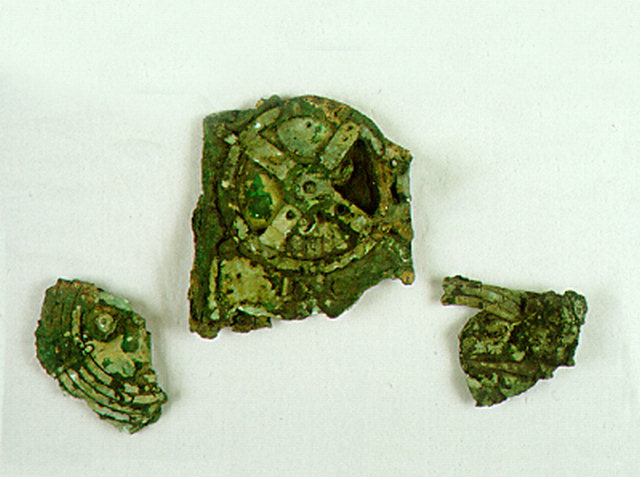
The Antikythera Mechanism (ca 80 AD)
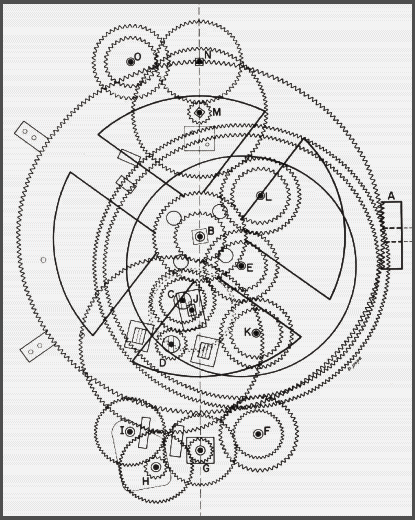
General Plan of All Gearing of the Antikythera Mechanism
(from De Solla Price, Trans of the Am Phil Soc 64, No 7, 1974)
As De Solla Price points out,"The Antikythera mechanism must therefore be an arithmetical counterpart of the much more familiar geometrical models of the solar system which were known to Plato and Archimedes and evolved into the orrery and the planetarium. The mechanism is like. a great astronomical clock without an escapement, or like a modern analogue computer which uses mechanical parts to save tedious calculation. […] It is certainly very similar to the great astronomical cathedral clocks that were built all over Europe during the Renaissance."
-
It must be noted that the Antikythera mechanism is one of kind—as a Greek artifact. There does not seem however to be any doubts as to its
authenticity. While the mathematical and astronomical principles underlying its construction are clearly withing the Greek/Hellenistic
scientific tradition, the technology itself would seem to be unique. Here is what De Solla Price has to say about this puzzle:
"It was just at this time that Islam was drawing on Greek knowledge and rediscovering ancient Greek texts. It seems likely that the Antikythera tradition was part of a large corpus of knowledge that has since been lost to us but was known to the Arabs. It was developed and transmitted by them to medieval Europe, where it .became the foundation for the whole range of subsequent invention in the field of clockwork. "On the one hand the Islamic devices knit the whole story together, and demonstrate that it is through ancestry and not mere coincidence that the Antikythera mechanism resembles a modern clock. On the other hand they show that the Antikythera mechanism was no flash in the pan but was a part of an important current in Hellenistic civilization."
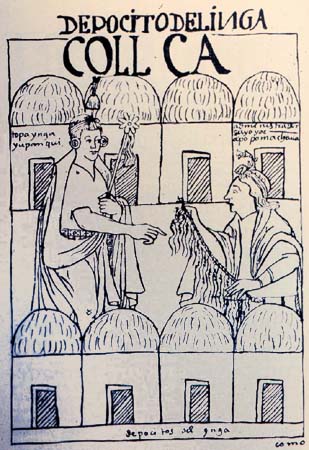
Inca Accountant (Collca = Warehouse) with Khipu
(According to Felipe Guaman Poma de Ayala, 1613)
Readings, Resources and Questions
- Visit The Horology Index, a very good starting point for the history of man's efforts to measure time.
-
Concerning calendars, a great website is NIST's
 A Walk Through Time: The Evolution of Time Measurement through the Ages.
A Walk Through Time: The Evolution of Time Measurement through the Ages.
- For resources and links concerning the many studies which try to establish the level of astronomical knowledge in prehistory, check Archaeoastronomy.
Picture Credits: University of Wisconsin · Hellenic Ministry of Culture · SUNY Buffalo
Ryerson University · IBM Zurich Laboratory · Fortunat F Mueller-Maerki
Last Modification Date: 04 July 2006